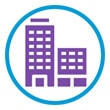Your cart is currently empty!
The Essential Guide to 3-Zone Protection in Hair Salons
As a hair salon owner, you’re focused on creating a beautiful experience for your clients. But it’s also critical to ensure that your salon environment is safe and healthy for both clients and staff. One of the biggest challenges facing salon environments is air quality, particularly concerning volatile organic compounds (VOCs). Here, we will delve into the benefits of implementing 3-zone protection in hair salons and how the system can drastically improve the air quality for you, your employees, and your clients.
Understanding VOCs in Hair Salons
Volatile organic compounds (VOCs) are chemicals that easily become vapors or gases, contributing to poor indoor air quality. In hair salons, VOCs are commonly produced through aerosol sprays, hair dyes, nail polishes, and notably during keratin treatments. These compounds can lead to several health issues, including respiratory problems, headaches, and skin irritation. It is crucial to monitor and control VOC levels to ensure a healthy salon environment.
Sources of VOCs
Key sources of VOCs in hair salons include:
- Hair Dyes and Bleaches: These products often contain ammonia and peroxide, which release VOCs.
- Aerosols: Hairsprays and texturizers can emit high levels of VOCs.
- Keratin Treatments: The processing and application of keratin treatment products can release formaldehyde, a known VOC.
- Nail Products: Although not always part of hair services, nail polish and removers contribute VOCs to the salon atmosphere.
The Importance of Ventilation in Keratin Treatments
Keratin treatments, while popular for their smoothing effects, pose particular risks due to the formaldehyde released during their application. Proper ventilation is not only recommended but crucial to ensure the health and safety of both clients and staff.
“Check to ensure that appropriate air ventilation is being used in the salon to control vapors and minimize the potential for sensory irritation. Salons that are not equipped with the appropriate ventilation needed to prevent sensory irritation should NOT provide these services until this situation is corrected. Proper ventilation that is appropriate for the services being performed in the salon is VERY important for both consumers and salon professionals. Aerovex Systems, one of our founding members, is the developer of a hair salon source capture ventilation system, which provides a premiere example of “appropriate” salon ventilation equipment. Such equipment is useful for many types of salon services, including keratin smoothing and can offer an extra level of ventilation to help ensure the safety and comfort of clients and cosmetologists.”
The Professional Keratin Smoothing Council
Implementing 3-Zone Protection in Hair Salons
A 3-zone protection system provides a comprehensive solution for maintaining air quality.

The Breathing Zone

The Room Zone

The Building Zone
Key Components of 3-Zone Protection
As you learned in our Salon 3-Zone Protection Basics, there are three key areas to consider when implementing a comprehensive ventilation system in your hair salon:
- Zone 1 – The Breathing Zone: Source Capture systems capture chemicals directly at the source.
- Zone 2 – The Room (the Salon) Zone: Utilize air purifiers to reduce background concentrations of VOCs throughout the salon.
- Zone 3 – The Building Zone: Building-wide HVAC Ventilation enhances overall air circulation and exchange with outdoor air, ensuring no buildup of harmful chemicals.

Specific Considerations for Hair Salons
Zone 1 – Your Breathing Zone
The easiest and most efficient way to prevent vapors and dust from getting into the hair salon is to provide the hair stylist with a Source Capture Ventilation System. Aerovex Chemical Source Capture Systems protect the breathing zone around the hair stylist and the client – the two-foot radius in front of the mouth. Every breath we take comes from the breathing zone. If vapors and dust are caught immediately they don’t become inhaled and make it past the work station and into the salon. If anything does get past the source capture ventilation system, it would be adsorbed by the The One That Works™ room air purifier.
Providing source capture ventilation during keratin hair smoothing services protects both the stylist’s and client’s breathing zone and prevents overexposure to excessive levels of formaldehyde. Source capture systems intake the chemical vapors that are created when stylists apply chemical treatments to the hair, during blow drying and flat ironing. Then they adsorb and contain the vapors.
Together, source capture ventilation and purification systems minimize what becomes part of the hair salon air. The hair stylists benefit in two ways. First, they breathe clean air – which makes for happier lungs while helping to eliminate sensory irritation (burning eyes, scratchy throat, runny nose, headaches). Second, they will never have to be concerned about the smell of the hair salon.
Zone 2 – Your Salon
In implementing 3-zone protection in hair salons, room air purification cleanses the work station and salon room air, further reducing the potential of overexposure to formaldehyde or other salon vapors and dust, and other particles and pathogens found in the salon.
All hair salon chemical vapors including formaldehyde are heavier than air and tend to migrate to the floor. It is important to choose a ventilation unit which not only contains a sufficient amount of adsorbent material, (i.e. 8 lbs activated carbon), but also moves a sufficient volume of air, (400 to 600 cubic ft. per minute). A hair salon ventilation unit like Aerovex’s The One That Works™ air purifier which provides a “Fountain Flow” of air by forcing clean air towards the ceiling will create the necessary airflow pattern to scrub contaminants from the hair salon air. Because salon vapors are in greatest concentrations at floor level, choose a unit designed to capture pollutants at the floor level.
Zone 3 – Your Building
A building’s ventilation system, whether in a strip mall or a stand alone structure, is called the HVAC system. These systems are professionally maintained by a specialist who changes the filters and properly balances and cleans the system every year. For additional protection, adding filters into vents leaving the salon helps keep fumes and dust from recirculating throughout the building into other businesses and back into the salon. The Dust Plus™ Filters have an increased dust holding capacity and are composed of two, rinseable layers of Electrostatic Polypropylene grids that collect and trap dust. The inside of the Dust Plus™ Filters are composed of an interchangeable Activated Carbon Panel which captures and removes salon specific chemical vapors.
Execution and Maintenance
Executing the installation of a 3-zone protection system involves several steps:
- Space Layout: Ensure the system design accounts for salon layout, number of stations, and airflow patterns.
- Volume of Services: Adjust specifications based on the number of services and staff shifts.
- Chemical Use: Systems should be robust enough to handle peak emission times, especially during back-to-back keratin treatments.
- Customization: Select a system that can be tailored to your salon’s layout and operations.
- Professional Installation and Routine Maintenance: Engage experienced professionals for both installation and ongoing system checks.
- Replace Filters: Know the filter replacement frequency requirements for your system and ensure you have enough spares on hand to replace them on time.
Book your free clean air consultation!
Aerovex has helped over 14,000 salons across the country improve their air quality by tackling the challenges of the three danger zones: Source, Room, and Building. Our team is up to date on the latest industry standards and regulations and ready to help you become clean air certified.
Benefits of 3-Zone Protection in Hair Salon Environments
Adopting a 3-zone protection system yields numerous benefits:
- Enhanced Safety: Significantly reduces staff and client exposure to harmful VOCs.
- Improved Health: Decreases health risks associated with poor air quality, like respiratory problems.
- Client Confidence: Demonstrates commitment to safety, potentially attracting more clients.
Regulations and Guidelines
Various regions have specific regulations regarding VOC emissions and air quality. For salons offering keratin treatments, guidelines often underscore the importance of proper ventilation to mitigate formaldehyde exposure. It’s advisable to stay informed about local ordinances and industry standards to ensure compliance.
Overcoming Challenges in Implementation
Common obstacles in implementing 3-zone protection in hair salons include cost, space constraints, and lack of staff training. However, these can be mitigated through:
- Budget Planning: Explore funding or financing options to spread out costs. Work in costs for ongoing filter replacements.
- Optimized Design: Work with specialists to accommodate space limitations.
- Proactively Updating Systems: Regularly update and maintain equipment to handle all chemical processes.
- Staff Training: Ensure that staff are educated on the importance of these systems and how they function.
- Communicating with Clients: Transparency about air safety measures can bolster trust and reassurance.
The Role of Training and Education
Proper training is pivotal to the successful implementation and maintenance of a 3-zone system. Educate your team on:
- System Operations: Understanding how the system functions and troubleshooting basic issues.
- Safety Standards: The importance of adhering to safety guidelines during treatments.
- Client Communication: Effectively communicating air quality measures to clients enhances trust.
Our Recommendation
Implementing a 3-zone protection system is an investment in the safety and health of everyone in your hair salon environment. By understanding the sources and solutions to VOC-related challenges, you provide a safer, more appealing space for both your clients and staff. With air quality as a priority, your salon can thrive in an environment that promotes beauty without compromising health.
Contact Aerovex Systems first. We are salon air quality and regulatory requirement experts. We recommend our 3 Zone Protection package for all stylists providing keratin hair smoothing services. Our Chemical Source Capture System is essential, and The One That Works room air purifier is highly recommended. Making sure your salon’s HVAC system filter removes VOCs’ is also recommended.
